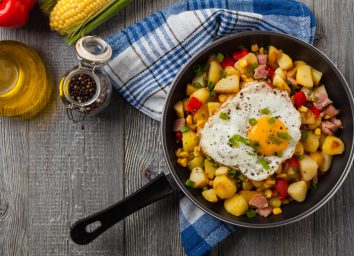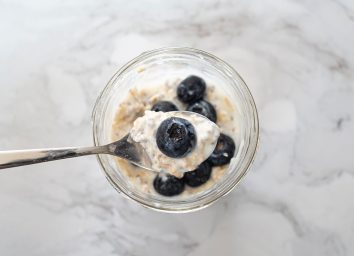Breakfast Habits To Avoid for Weight Loss After 50, Say Experts
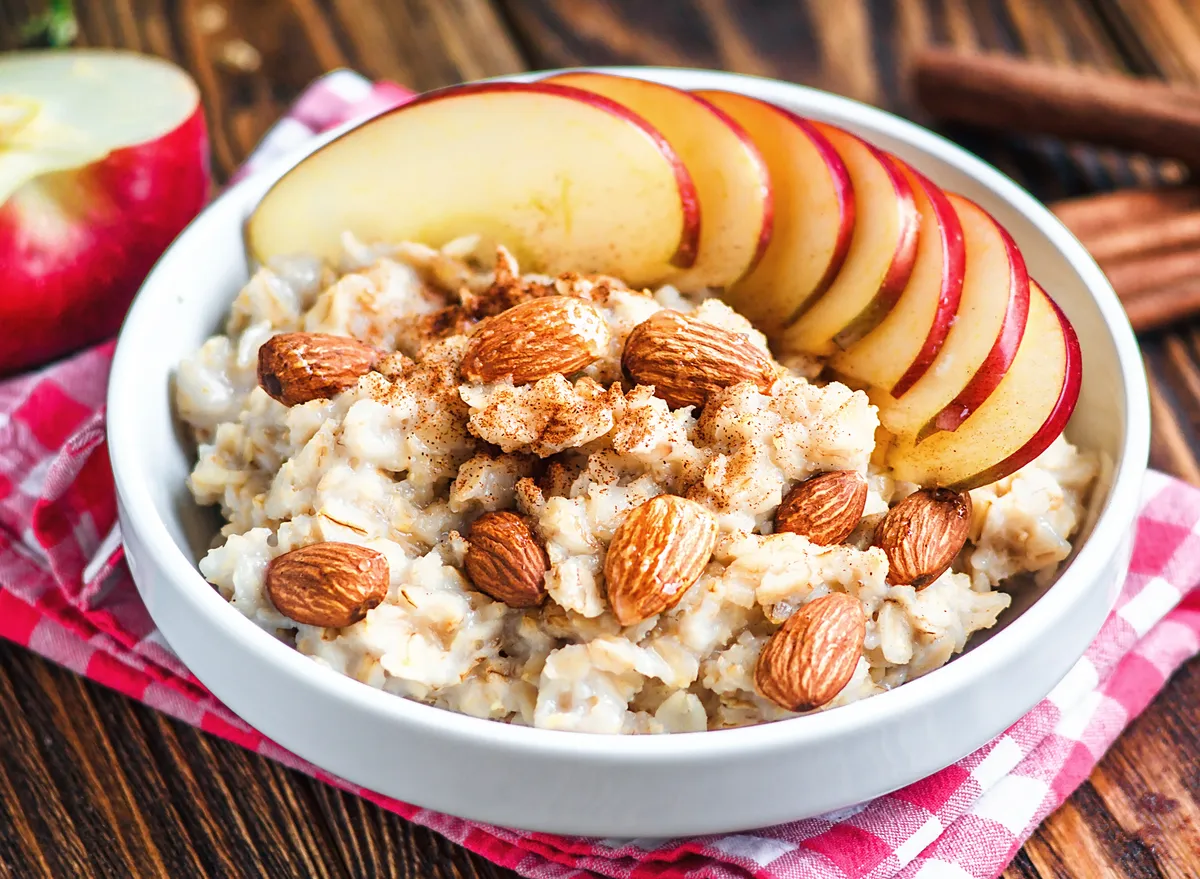
Breakfast, the so-called “most important meal of the day,” is often a nutritional disaster in the U.S. Instead of eating what we ate for dinner the day before like people in many other countries do (that is, proteins and fiber-rich vegetables), we Americans limit our choices to traditional “breakfast foods,” many of which are so sugary, you can call them candy. Nearly every registered dietitian and nutrition expert we queried about bad breakfast habits to break had the same advice: The No. 1 thing you should stop doing after 50 is eating sugar for breakfast. Sugar-sweetened foods and those high in fast-burning carbohydrates that lack fiber quickly elevate blood sugar, kicking off a rollercoaster of cravings.
When you don’t eat protein, fats, and fiber, which slow the release of sugar into your bloodstream, your blood sugar can rise and fall at an abnormally rapid rate.
“That causes you to crave more sugar and overeat later on,” says Melissa Mitri, RD, a registered dietitian for Wellness Verge. She adds that eating highly processed carbs like sugary cereals and the refined flour in white bread, bagels, and pastries for breakfast is one of the worst things you can do for weight loss and good health.
However, eating a sugary breakfast isn’t the only thing you’ll want to avoid if you’re over 50 and trying to lose weight. Aging in general can bring about certain bodily changes that may make it more difficult to lose weight. For example, women going through menopause may have a harder time because of hormonal changes, and both men and women will begin to lose muscle mass as they age, which may lead to a slower metabolism. Because of these increased difficulties, it’s beneficial to your health to upgrade your routine to incorporate better habits while you still can and drop those that may not be serving your weight loss goals well.
Read on to learn more about the breakfast habits to avoid as you age—and for more healthy eating tips, make sure to also check out The 5 Best High-Protein Foods To Eat After 50.
Not consuming fruits or vegetables
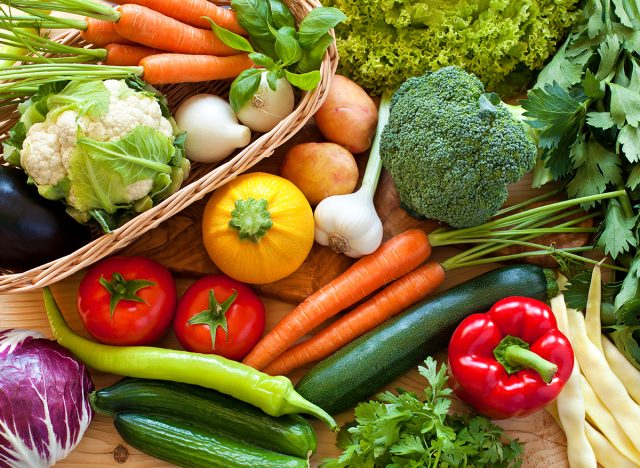
Getting enough fruit and vegetables into your breakfast can be a challenge, especially if you’re used to grabbing a quick meal like a bagel or a breakfast bar. However, research shows that eating enough produce is crucial for weight loss.
In one study analysis published by British Medical Journal Open, it was found that eating more produce, with a specific focus on fruit, led to a decrease in abdominal fat among women between the ages of 35–69 years old. Also, a review published in Nutrients found that more daily servings of vegetables were associated with greater loss of waist circumference in women.
Not eating protein
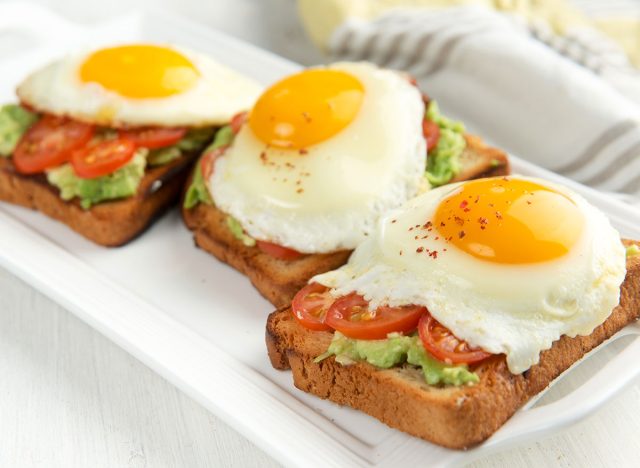
“Skimping on protein for breakfast is never a good idea because protein keeps you full and satisfied, and it helps control appetite all day long,” says Mitri. “Protein is essential for people over 50, as it helps maintain lean muscle mass for a healthy metabolism.”
According to a report from the Journal of Obesity & Metabolic Syndrome, eating a diet high in protein has been found to help with weight loss and keeping weight off by both increasing your satiety after meals and leading to a reduced food intake.
If you’re in need of some ideas for how to get more protein in at breakfast, try adding in eggs, plain Greek yogurt, nut butter, or cottage cheese.
Eating sugary granola
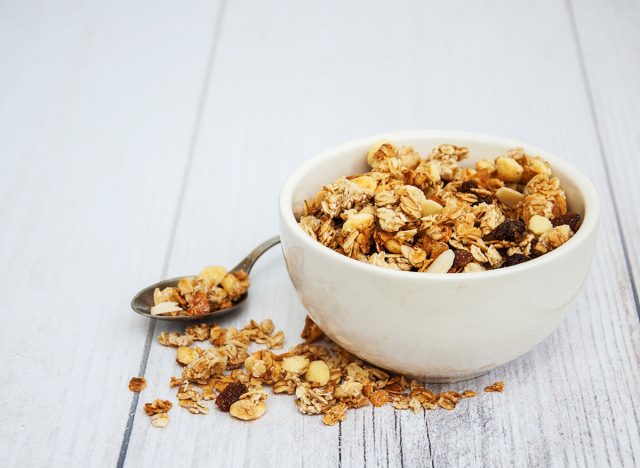
“Granola is often touted as being ‘natural,’ ‘low sodium,’ ‘non-GMO,’ or ‘gluten-free,’ which sounds healthful. But make sure to read the ingredients label, because granola is often loaded with sugar,” says dietitian Jinan Banna, RD, Ph.D., a professor of nutrition at the University of Hawaii at Mānoa.
Not only that, but granola can oftentimes come with a lot of sugar and not a ton of protein or fiber to balance it out. For example, Nature’s Valley Dark Chocolate Granola has 8 grams of added sugar in just a 1/4 cup serving, with only 2 grams of fiber and 2 grams of protein.
Not getting enough fiber
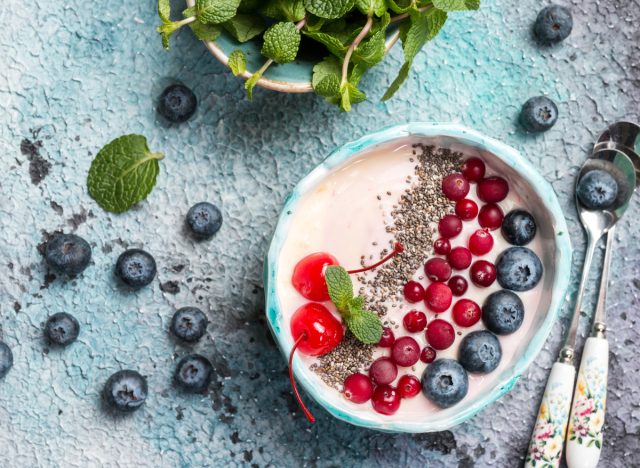
Getting enough fiber is crucial for weight loss after 50 because “fiber helps you maintain a healthy weight as it passes through the body undigested, contributing little in the way of calories,” says Banna.
Your metabolism may naturally start to slow down as you age, and dietary fiber has been found to help improve metabolism and overall weight management.
Break the habit of not getting enough fiber into your breakfast meal by making sure it includes fruits and vegetables, which are naturally high in fiber and low in calories.
Skipping breakfast
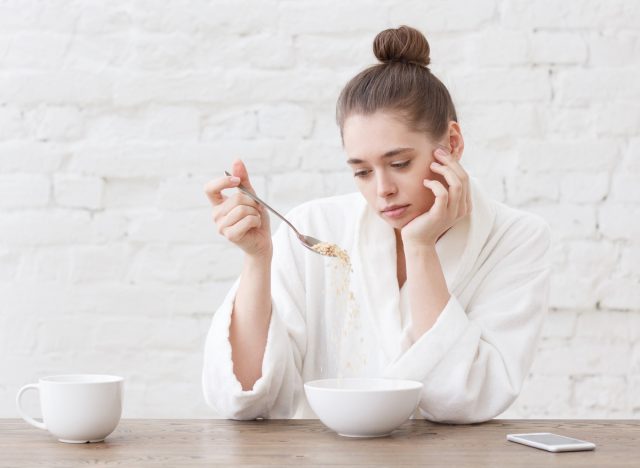
Skipping breakfast can sometimes have positive effects if you’re doing it as part of an intermittent fasting plan. But going for many hours without food after waking up can negatively impact your brain health and function, which may in turn affect your dietary choices throughout the day, warns Trista Best, RD, MPH, a registered dietitian at Balance Once Supplements.
“When glucose levels drop to a very low level, people experience brain fog, mental fatigue, and irritability,” says Best. “Breakfast is a way to set the tone for how you will eat the rest of the day. A nutrient-rich breakfast will likely lead to better food choices in the rest of the day’s meals.”
Only drinking coffee
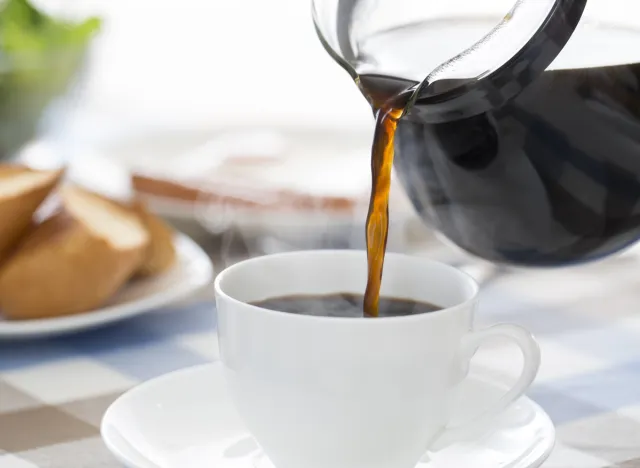
If your idea of breakfast is a cup of coffee—well, that’s essentially just as bad as skipping breakfast. In fact, it may be even worse.
“Coffee suppresses our hunger cues for a while. But then once it’s digested, you may find yourself feeling like you’re starving,” says Mitri. “This makes it harder to control your portions and make good choices later in the day. You can still enjoy your morning cup of Joe, but pair it with a balanced breakfast.”
Grabbing a protein-heavy breakfast bar
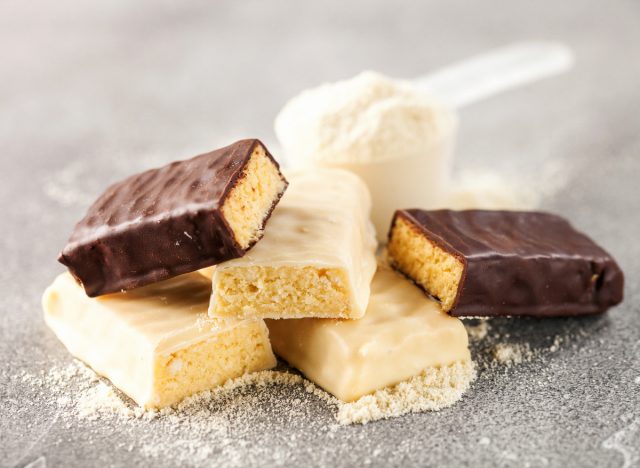
Some breakfast protein bars, especially those made with chocolate and peanut butter, pack more calories and carbs than a candy bar, says Best. Take the Gatorade Recover Peanut Butter Chocolate Whey Protein Bar, for example. It contains 350 calories, 25 grams of sugar, and 20 grams of protein. ”
“As a general rule, the sugar in a healthy protein bar shouldn’t be higher than its protein content,” says Best.
Making waffles
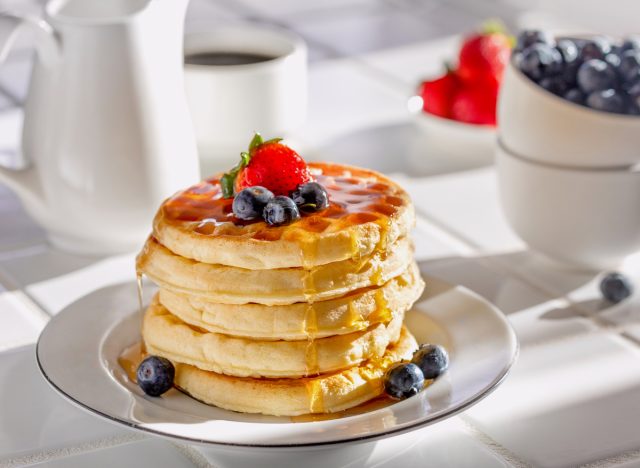
This goes for pancakes, too. Two homemade waffles or pancakes can pack around 30 grams of fast-burning carbs thanks to the refined white flour from which they are typically made. But don’t forget step two before you start forking them into your mouth: Pouring on the syrup—aka, liquid sugar.
A two-tablespoon serving contains about 24 grams of added sugars and 100 calories, but who uses just two tablespoons of the sweet stuff? What’s more, most commercial syrups (we’re looking at you, Mrs. Butterworth’s) are made of high fructose corn syrup, corn syrup, water, salt, and cane syrup. High levels of sugar, especially fructose from high fructose-laden pancake syrup, increase inflammation in the body, according to a study in Nature Communications.
Visiting the drive thru

Your 50s can be a busy time. For example, if you have kids in middle or high school, you may be spending most of your days driving them to and from school, practices, or friends’ houses. This may mean that fast food is the best, most convenient option for you and your family.
Fast food tends to be high in calories, sodium, saturated fat, and sugar—all the things you don’t want if you’re trying to lose weight over 50. That’s why dietitians strongly encourage eating more food at home instead of swinging into a drive thru.
“Eat ‘real food’ that comes from nature, not a box, can, or bag whenever possible,” says registered dietitian nutritionist Laura Krauza, MS, LDN, of Waistline Dietitian. “Real food has the nutrients that the body’s control panel can use to register hunger and fullness sensations, so you won’t overeat.”
In fact, a study published in the International Journal of Behavioral Nutrition and Physical Activity found that cooking more meals at home was associated with a lower BMI.
Filling up a smoothie bowl
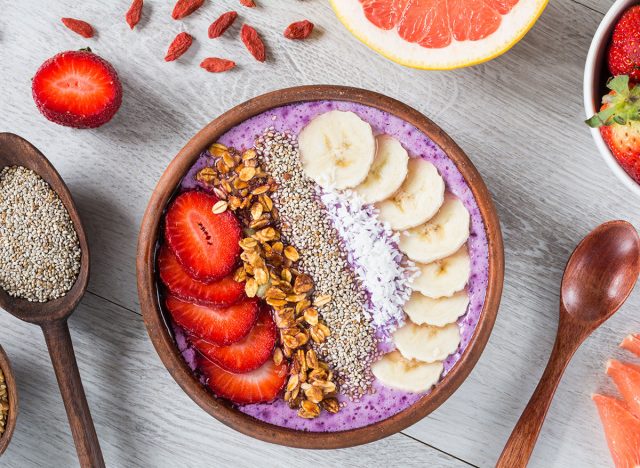
A smoothie bowl made with high-protein Greek yogurt can be a terrific breakfast for weight loss, except when you load it up with tons of toppings. Adding tons of nuts, granola, and honey for sweetness can add up to hundreds of calories that you don’t need if you’re trying to drop pounds. Another unhelpful habit is having a smoothie as your beverage with a full breakfast.
“Adding smoothies to your meals may result in too many calories and weight gain,” says Brenda Braslow, MS, RDN, a registered dietitian with MyNetDiary.
Instead, drink a high-protein smoothie as your main meal to melt pounds.
Leaving home dehydrated
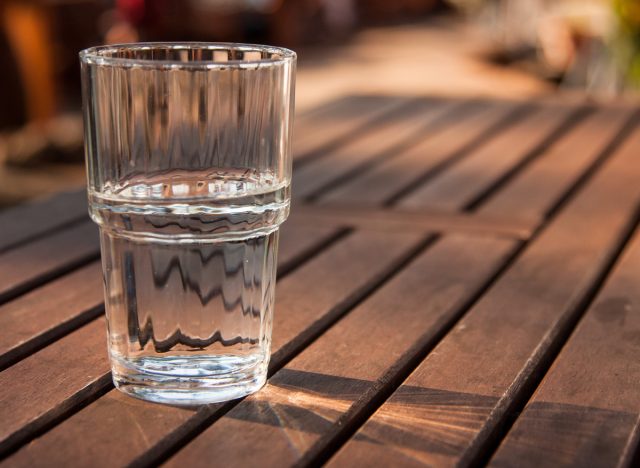
How many of you rush out the door in the morning after chugging only coffee? Fueling up on coffee without water or food will set you up not only for hunger and concentration problems later on, but dehydration, says nutritionist Heather Hanks, MS, CAM, of Medical Solutions BCN.
“Always balance your coffee intake with water so you’re properly supporting your metabolism and digestion without getting dehydrated,” says Hanks.
According to Mayo Clinic, your risk of dehydration increases as you age because of a shrinking fluid reserve in your body and a changing ability to conserve water. So, getting in the habit of drinking enough water in your 50s can help you into your 60s, 70s, and beyond.
Consuming sugary coffee drinks or juices
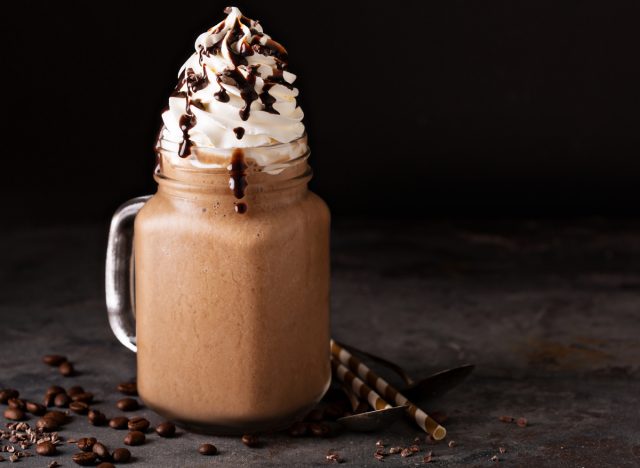
You really can’t call them coffee.
“They are loaded with sugar and artificial colorings, flavors, and preservatives that are extremely dense with calories, leaving us hungry shortly after we drink them because of the lack of nutrients,” says Silvia Carli, MS, RD, a registered dietitian and certified strength and conditioning coach with 1AND1 LIFE.
Research shows that regular sugar-sweetened beverage consumption is associated with increased weight gain, as well as cellular aging that may increase risk of metabolic disease, which makes these drinks a double whammy in potential harm as you age.
The same thing can be said for fruit juices with added sugar. They contain no fiber, so they won’t contribute much to making you feel satisfied, she says. Always choose whole fruit over fruit juice, and real coffee over sweet coffee drinks.
Using artificial sweeteners
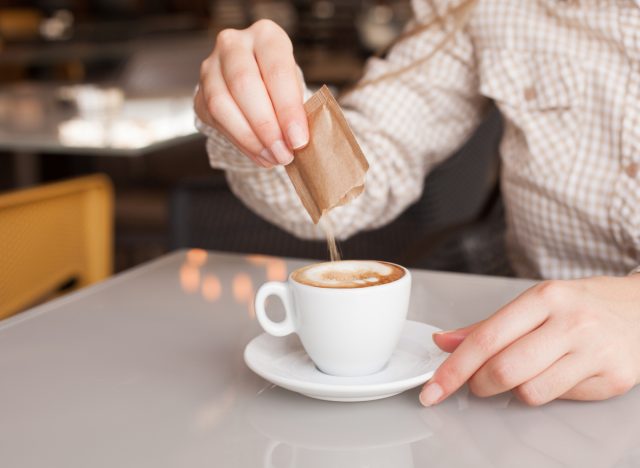
Dumping those colorful packets of non-nutritive sweeteners into your tea or coffee can backfire on the 50-plus body trying to shed some weight.
“Having your taste buds start the day off super sweet is not ideal,” warns registered dietitian Marissa Meshulam, MS, RD, CDN, owner of MPM Nutrition. “It sets your body up to crave sugar later on. Plus, when you are used to sipping on super sweet beverages, you won’t find natural sugars, even fruit, as sweet anymore.”
A meta-analysis from the Canadian Medical Association Journal of 37 studies and over 400,000 people found that consuming drinks with artificial sweeteners at least once a day was associated with more weight gain and risk of things like obesity, heart disease, and diabetes.
A previous version of this story was published on December 20, 2021. It has been updated to include additional copy and proofreading revisions, additional research, and updated contextual links.
- Source: https://pubmed.ncbi.nlm.nih.gov/22978257/
- Source: https://www.mayoclinic.org/healthy-lifestyle/weight-loss/in-depth/metabolism/art-20046508
- Source: https://www.ncbi.nlm.nih.gov/pmc/articles/PMC5898328/
- Source: https://www.ncbi.nlm.nih.gov/pmc/articles/PMC6266069/
- Source: https://www.ncbi.nlm.nih.gov/pmc/articles/PMC7539343/
- Source: https://www.longdom.org/open-access/a-review-of-physiological-effects-of-soluble-and-insoluble-dietary-fibers-2155-9600-1000476.pdf
- Source: https://fdc.nal.usda.gov/fdc-app.html#/food-details/568644/nutrients
- Source: https://fdc.nal.usda.gov/fdc-app.html#/food-details/169661/nutrients
- Source: https://www.nature.com/articles/s41467-021-21461-4
- Source: https://www.ncbi.nlm.nih.gov/pmc/articles/PMC5561571/
- Source: https://www.mayoclinic.org/diseases-conditions/dehydration/symptoms-causes/syc-20354086
- Source: https://pubmed.ncbi.nlm.nih.gov/16895873/
- Source: https://www.ncbi.nlm.nih.gov/pmc/articles/PMC4229419/
- Source: https://www.cmaj.ca/content/189/28/E929

